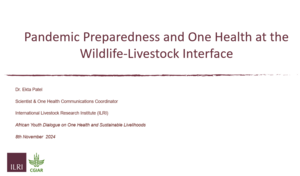
Key influencers in Burkina Faso's poultry management: Insights from systems mapping and network analysis
Abstract
Background: Effective management of livestock systems is essential for optimizing productivity and sustainability. This research utilizes systems mapping and network analysis to identify pivotal elements within poultry management concepts. The aim is to ascertain nodes that exert significant influence on operational efficiencies and policy formulation, thus supporting livelihoods and economic resilience in livestock-dependent communities.
Methods: We employed a mixed-methods approach incorporating both qualitative interviews and quantitative data analyses to construct a network model. This model includes variables such as hygiene practices, livestock profitability, educational attainment, and access to services. Network analysis metrics degree centrality, betweenness centrality, and closeness centrality were calculated using Kumu software to identify key nodes. Systems mapping provided a visual framework to elucidate the interdependencies and potential impacts of these nodes.
Results: Analysis of the network identified ‘Household Economics’, ‘Livestock Practices’, and Livestock Loss & Profits’ as nodes with the highest degree centrality, indicating their central role in the network. ‘Livestock Loss & Profits’, ‘Household Economics’, and 'Access to External Livestock Services' as nodes with the highest betweenness centrality indicating the higher control over the flow of information. ‘Household Economics’ and ‘Livestock Loss & Profits’, ‘Education Level’ had the highest closeness centrality indicating their role as key hubs through which interventions could rapidly permeate and influence the entire livestock management system. Their central position also marks them as strategic targets for policies aimed at boosting economic resilience and reducing vulnerability across the network. "Livestock Practices," "Livestock Loss & Profits," and "Household Illness," by virtue of their high eigenvector centrality, function as principal conduits within the network, their significance amplified by their direct links to other central nodes.
The MICMAC analysis, a method used to identify and classify variables based on their driving power and dependency within a network, highlights "Educational Level" as the most influential node with a value of 1.000, underscoring its central role in effectuating systemic changes. "Livestock Loss & Profits" is also significant, with an influence score of 0.752, playing a crucial role in the economic dynamics of the system. "Hygiene Practices" and "Poultry Consumption," each with a MICMAC value of 0.729, emerge as key drivers affecting public health and economic outputs, indicating that targeted improvements in these areas could yield extensive positive effects across the network.
Conclusions: The network analysis underscores the pivotal importance of nodes associated with education and economic factors due to their central positioning throughout the network, emerging as strategic areas where targeted poultry system interventions could catalyze improvements across the system, potentially reducing vulnerabilities and increasing productivity. The adoption of a user-friendly network mapping presents a systems approach for resolution and communication within poultry management and foundation for complex systems analysis.
Citation
Boz, Z., Dione, M., Alders, R., Kagambèga, A., Knight-Jones, T., Ilboudo, G., Ouedraogo, B., Ima-Ouoba, S. and Ganser, S. 2024. Key influencers in Burkina Faso's poultry management: Insights from systems mapping and network analysis. Presentation at the 8th World One Health Congress, Cape Town, South Africa, 20–24 September 2024. Nairobi, Kenya: ILRI.










